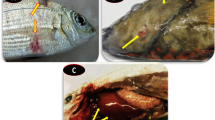Abstract
Due to the limitation of accessible laboratory facilities for disease diagnosis at the time of the events, clinical samples of snubnose pompano (Trachinotus blochii) and orange-spotted grouper (Epinephelus coioides) were frozen preserved for retrospective investigation. This study employed a simple challenged test using crude homogenate prepared from the long-term frozen preserved tissues (~ 16 months) to infect Asian sea bass (Lates calcarifer) model. The experimental fish became sick and exhibited visceral white spots similar clinical signs previously observed in natural cases. Two morphologically different Gram-positive bacteria were concurrently recovered from the experimentally sick fish but not directly from the archived frozen tissue. Based on sequence homology of 16S rRNA, the bacterial strains were identified as Nocardia seriolae and Streptococcus iniae, respectively. Subsequent specific PCR assays confirmed co-infections of N. seriolae and S. iniae in the majority of naturally diseased fish preserved. Concurrent infection of N. seriolae and S. iniae is new to both pompano and grouper. This study also suggests that frozen preservation combined with challenged assay might be useful for retrospective diagnosis and recovery of infectious agents in under-equipped laboratories in Southeast Asia or elsewhere.



Similar content being viewed by others
References
Agnew W, Barnes AC (2007) Streptococcus iniae: an aquatic pathogen of global veterinary significance and a challenging candidate for reliable vaccination. Vet Microbiol 122:1–15
Bowater RO, Forbes-Faulkner J, Anderson IG, Condon K, Robinson B, Kong F, Gilbert GL, Reynolds A, Hyland S, McPherson G, Brien JO, Blyde D (2012) Natural outbreak of Streptococcus agalactiae (GBS) infection in wild giant Queensland grouper, Epinephelus lanceolatus (Bloch), and other wild fish in northern Queensland, Australia. J Fish Dis 35:173–186
Bromage ES, Thomas A, Owens L (1999) Streptococcus iniae, a bacterial infection in barramundi Lates calcarifer. Dis Aquat Org 36:177–181
Colorni A, Diamant A, Eldar A, Kvitt H, Zlotkin A (2002) Streptococcus iniae infections in Red Sea cage-cultured and wild fishes. Dis Aquat Org 49:165–170
Dong HT, Nguyen VV, Le HD, Sangsuriya P, Jitrakorn S, Saksmerprome V, Senapin S, Rodkhum C (2015) Naturally concurrent infections of bacterial and viral pathogens in disease outbreaks in cultured Nile tilapia (Oreochromis niloticus) farms. Aquaculture. 448:427–435
Dong HT, Jitrakorn S, Kayansamruaj P, Pirarat N, Rodkhum C, Rattanarojpong T, Senapin S, Saksmerprome V (2017a) Infectious spleen and kidney necrosis disease (ISKND) outbreaks in farmed barramundi (Lates calcarifer) in Vietnam. Fish Shellfish Immunol 68:65–73
Dong HT, Taengphu S, Sangsuriya P, Charoensapsri W, Phiwsaiya K, Sornwatana T, Khunrae P, Rattanarojpong T, Senapin S (2017b) Recovery of Vibrio harveyi from scale drop and muscle necrosis disease in farmed barramundi, Lates calcarifer in Vietnam. Aquaculture. 473:89–96
FAO 2012 Regional overview of fisheries and aquaculture in Asia and the Pacific 2012. RAP Publication 2012/26, Available at [http://www.fao.org/docrep/017/i3185e/i3185e3100.htm]
Giang N, Binh D, Hoa D (2012) Preliminary study of white spot disease in internal organs in snubnose pompano (Trachinotus blochii). J Fish Sci Technol 4:26–33 (In Vietnamese)
Kotob MH, Menanteau-Ledouble S, Kumar G, Abdelzaher M, El-Matbouli M (2016) The impact of co-infections on fish: a review. Vet Res 47:98
Labrie L 2008 Nocardial infections in fish : an emerging problem in both freshwater and marine aquaculture systems in Asia. Diseases in Asian Aquaculture 297–312
Luna LG (1968) Manual of histologic staining methods of the Armed Forces Institue of Pathology. McGraw-Hill, New York
Maalej S, Gdoura R, Dukan S, Hammami A, Bouain A (2004) Maintenance of pathogenicity during entry into and resuscitation from viable but nonculturable state in Aeromonas hydrophila exposed to natural seawater at low temperature. J Appl Microbiol 97:557–565
Mata AI, Blanco MM, Dominguez L, Fernandez-Garayzabal JF, Gibello A (2004) Development of a PCR assay for Streptococcus iniae based on the lactate oxidase (lctO) gene with potential diagnostic value. Vet Microbiol 101:109–116
Miyoshi Y, Suzuki S (2003) A PCR method to detect Nocardia seriolae in fish samples. Fish Pathology 38:93–97
Oliver JD 2005 The viable but nonculturable state in bacteria. J Microbiol 43 Spec No, 93–100
Ramamurthy T, Ghosh A, Pazhani GP, Shinoda S (2014) Current perspectives on viable but non-culturable (VBNC) pathogenic bacteria. Front Public Health 2:103
Shimahara Y, Huang YF, Tsai MA, Wang PC, Yoshida T, Lee JL, Chen SC (2009) Genotypic and phenotypic analysis of fish pathogen, Nocardia seriolae, isolated in Taiwan. Aquaculture. 294:165–171
Tamura K, Stecher G, Peterson D, Filipski A, Kumar S (2013) MEGA6: Molecular Evolutionary Genetics Analysis Version 6.0. Mol Biol Evol 30:2725–2729
Toranzo AE, Magarinos B, Romalde JL (2005) A review of the main bacterial fish diseases in mariculture systems. Aquaculture. 246:37–61
Vu-Khac H, Duong VQ, Chen SC, Pham TH, Nguyen TT, Trinh TT (2016) Isolation and genetic characterization of Nocardia seriolae from snubnose pompano Trachinotus blochii in Vietnam. Dis Aquat Org 120:173–177
Wang PC, Chen SD, Tsai MA, Weng YJ, Chu SY, Chern RS, Chen SC (2009) Nocardia seriolae infection in the three striped tigerfish, Terapon jarbua (Forsskal). J Fish Dis 32:301–310
Weisburg WG, Barns SM, Pelletier DA, Lane DJ (1991) 16S ribosomal DNA amplification for phylogenetic study. J Bacteriol 173:697–703
Acknowledgments
The National Center for Genetic Engineering and Biotechnology (BIOTEC) under its human resource development program provided a research fellowship to VV Nguyen. The authors thank C. Techatanakitarnan for technical assistance.
Author information
Authors and Affiliations
Corresponding authors
Ethics declarations
Conflict of interest
The authors declare that they have no conflict of interest.
Ethical approval
All applicable international, national, and institutional guidelines for the care and use of animals were followed by the authors.
Additional information
Publisher’s note
Springer Nature remains neutral with regard to jurisdictional claims in published maps and institutional affiliations.
Rights and permissions
About this article
Cite this article
Nguyen, V.V., Rodkhum, C., Senapin, S. et al. Retrospective diagnosis of archived marine fish experienced unexplained mortality reveals dual infections of Nocardia seriolae and Streptococcus iniae. Aquacult Int 27, 1503–1512 (2019). https://doi.org/10.1007/s10499-019-00403-4
Received:
Accepted:
Published:
Issue Date:
DOI: https://doi.org/10.1007/s10499-019-00403-4




